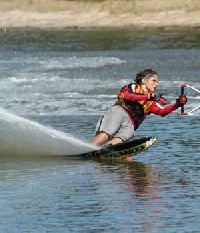
Waterskiing with one ski presents its own unique challenges to the human spirit
For the avid lover of water sports who has experienced the different varieties of water-skis, the next step on the adventure agenda may well be one ski and the art of slalom waterskiing. Although similar in sound to shalom, the Hebrew word for hello, goodbye and peace, the origin of this word lies in a Norwegian dialect and is taken specifically from two words; ?sla? meaning slightly inclining hillside and ?lam,” meaning tracks after skis.
Slalom waterskiing has its own set of rules, which were originally developed by Sir Arnold Lunn in 1922 for the British National Ski Championships and later adopted for the 1936 Winter Olympics. Today, the International Ski Federation determines and manages the rules of slalom waterskiing. Slalom and Giant Slalom make up the ?technical events? in alpine ski racing, which separates them from the ?speed events? like Super-G and Downhill. For those who live in warmer climes, slalom is defined as waterskiing with only one ski through a course very similar to the downhill skiing version. The boat drives through the middle buoys while the skier cuts through the water from side to side, rounding a buoy on each pass.
~
What should you look for when selecting a pair of slalom water-skis and accessories?
The sport of slalom waterskiing requires special equipment and two very important factors to consider when selecting slalom water-skis are your weight and the speed at which you usually ski. Some other considerations include:
1- Skill Level
While shopping around and considering different manufacturers of different types of water-skis, choose one that matches your level and skill and not the color of your ski suit. This is very important because if you are a beginner and buy a ski meant for a more experienced skier, you can easily lose control and it could cause serious injury. The good news about this is that manufacturers design slalom skis to match all levels of skill.
2- Bindings/ Boots
The operative word here is snug but not tight. In slalom waterskiing, ski bindings that are too tight can cause injuries, such as breaking an ankle or knee. This can be the result of a ski that is too tight and does not properly release from the foot upon falling. Different types of boot make-ups range from simple toe plates where the foot is directly inserted to the more complex bindings, which cover the entire foot up to the ankle.
3- Fin System
An adjustable fin system will allow the slalom water-skier to adapt it to his or her individual skiing style. Adjusting this system presupposes a working knowledge of what the fin is supposed to do. Generally speaking, the front half facing the nose affects the front of the ski and the back side of the fin facing the tail affects the back of the ski. Both the front and back movements of the fin affect the radius of any turn. Most manufacturers have factory settings recommended for average use.
Slalom waterskiing is a thrilling water-sport, but like all sports, danger is inherent with misuse of equipment, loss of control, poor judgment etc. Learn all you can about slalom waterskiing so that you can be prepared for what lies ahead. In the meantime, have fun and watch out?
Here comes a really big wave!

